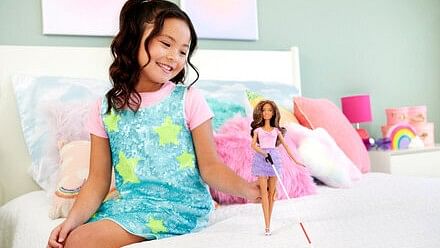
The doll, which comes in a pink box with Braille lettering, has its own special accessories, including a red-and-white cane with a marshmallow roller tip and sunglasses suited for light-sensitive eyes.
Credit: X/@isham_christy
In the decades since Barbie debuted in 1959, the doll's plastic perfections have generated criticism for their promotion of unrealistic beauty standards. In response, Mattel has tried to create versions that are more representative of a broader range of people.
On Tuesday, the company released a Barbie designed in partnership with the American Foundation for the Blind.
The doll, which comes in a pink box with Braille lettering, has its own special accessories, including a red-and-white cane with a marshmallow roller tip and sunglasses suited for light-sensitive eyes.
Its satin blouse and ruffled skirt were selected after Mattel tested them for tactile satisfaction with blind and low-vision children. The doll also has bendable arms for cane use.
Lucy Edwards, a social media influencer and disability activist who lost her sight when she was 17, called the doll "gorgeous" and "glam" in an online video that showed her taking it out of the box.
"I know when I'm picking clothes as a blind woman, I just love to feel my best in different textures, just like Blind Barbie," said Edwards, a Mattel brand ambassador.
Tameka Simmons, a disability activist in Greenville, South Carolina, took her blind 8-year-old daughter, Evely, to a Target store Tuesday to pick up one of the dolls.
"As a mom who has a blind child that has faced numerous challenges, this Barbie holds significance for my family," Simmons said. "We were overwhelmed with excitement when we heard about the doll's release. We're so glad she's here.
"My two other daughters also love Barbie so she's always hearing her sisters play with their Barbies," she added. "They came along with us in the car ride, and they were telling Evely that the doll has a cane just like you. That now she has a Barbie of her own."
The blind doll was released alongside Mattel's first Black Barbie with Down syndrome, which was developed with input from the National Down Syndrome Society. Mattel noted that the doll's palms "include a single line, a characteristic often associated with those with Down syndrome".
Some of the hearts on its dress have three arrows that "represent the third 21st chromosome that individuals with Down syndrome have," the company said.
Krista Berger, a senior vice president at Mattel, said the new dolls reinforced the company's "commitment to creating products that represent global belonging and inclusivity."
Both Barbies join the Fashionistas line, which Mattel launched in 2009. It features dolls with different skin tones, body types and disabilities, including a Barbie that uses a wheelchair, a Barbie with vitiligo and a Ken with a prosthetic leg.
Though the blind Barbie is the first blind doll in the Fashionistas line, Mattel introduced a blind Barbie in the form of Helen Keller as part of its Inspiring Women Series in 2021.
Debbie Miller, a spokesperson with the Royal National Institute of Blind People in Britain, shared her feelings about the release of the blind Barbie in a video.
"The impact of this for me when I was younger would have been incredible," she said. "I didn't know anyone else like me, so I felt really, really different, and if anything, I wanted to try and hide the fact that I was developing sight loss."
She continued, "It would have made me feel more confident to own it and talk to other people about it.
"It's cool to have a cane," she said. "Barbie's got one."